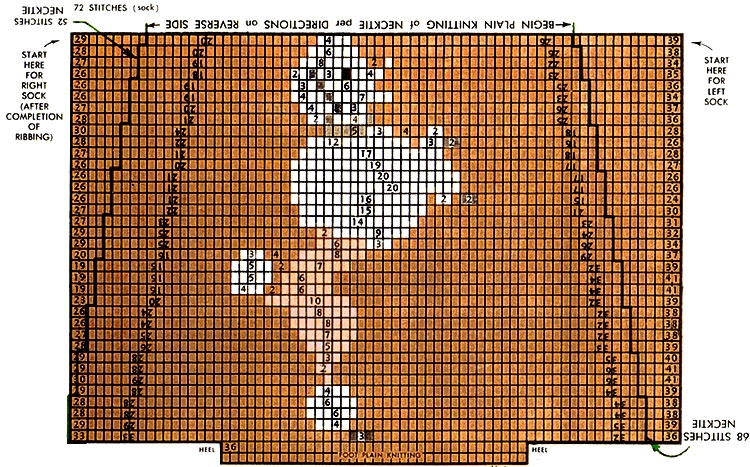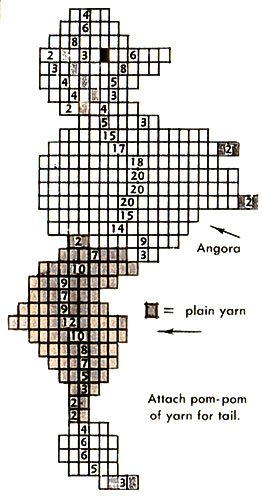Poodle Socks and Necktie Pattern #7291

Simplified multi-color knitting with color charts. Stitch sequences numbered. Each row knitted across and purled back in the same colors.
Knit right and left socks, if you wish. This pattern also suitable for working into a sweater or dress design.
Poodle design itself can also be knitted into a car charm.
IMPORTANT
Knit across and purl back each row before starting next row. Use size NUMBER ONE needles. Knitting tension should be tight enough to produce about 10 stitches per inch. If you do not obtain this gauge, then change to larger or smaller needles as your particular knitting tension requires. The size needle does not matter as long as the stitch gauge is correct. Note: 10 stitches per inch means 'as knit', without allowance for blocking. Socks then block to about 9 stitches per inch on usual size dryers, and will cling snugly to the average size leg when worn. For a very small size leg (such as 7 inches around above ankle) you may wish to knit to a tighter tension gauge than mentioned above, using the smallest possible needles. Use your own choice of yarn colors.
NOTE: (SOCK AND NECKTIE PATTERN)
In choosing yarn, be sure colors selected are in good contrast to show the design in sharp detail. Poodle is shown as clipped for a male dog. Use Angora in the parts shown in light Pink, plain yarn in parts shown darker. Somewhat different shades of this Angora and plain yarn, will show the design in a striking manner. Suggested alternate colors: Mint Green background with Grey or Black poodle. Red collar; Dark Green or Dark Blue background with White dog, shocking Pink collar; Beige, Green or Yellow sock, Brown poodle, Orange collar.
DIRECTIONS
(Basic instructions for beginners on the manner of casting-on, how to knit, purl, decrease, etc., cannot readily be given here. These details are usually obtainable free, from your yarn shop.)
MATERIALS: Note: Different brands of yarn vary in yardage. The following yarn quantities for an average size pair of socks, are approximate only.) 2½ oz. basic color (brown), 18 yds. (1 ball) pink Angora, 4 yds. plain pink, 1 yd. ea. grey markings (eye, outline of ear, etc.) and green for collar. Socks illustrated are 7 inches long above top of heel, including 2 inches of ribbing. If longer or shorter socks are desired, change length of ribbing or number of plain rows at top or bottom. Use size NUMBER ONE sock needles, double pointed, and regular 3-ply sock yarn.
Note: The use of 100% Angora of medium weight is recommended. Some brands of this yarn are of heavy texture and their use tends to dominate the pattern, spoiling the design. In case of such heavy yarn, the lighter weight may be obtained by untwisting one ply, then knitting with the part remaining.
IMPORTANT (Handling Yarn)—Use needles and yarn in the above accurate sizes in order to have sock of proper size per this pattern. Knitting tension should produce 10 stitches per inch. Use BOBBINS to carry your yarn in small quantities of each color. These will dangle clear of your work, avoiding entanglement. For certain small areas of color involving only a few stitches, you may prefer to merely use SHORT STRANDS of yarn, 12 to 15 inches long, dangling free, instead of bothering to wind separate bobbins. RECOMMENDATION—Make free use of additional bobbins or short strands as new color groups are encountered. A given strand will often be used over again for stitches in the same color group in the following rows, so be sure it is started long enough for the color group it is to handle. CAUTION—It is not desirable to carry one color yarn across the wrong side of another color, to reach stitches of the same color farther along the row. This would save extra strands of yarn, but in so doing the tension variation is likely to cause distortion of the stitches and thus spoil the clarity of the design. In some cases this carry-over of yarn can be accomplished satisfactorily across only one or two stitches of another color, where design detail is not too critical. Some experienced knitters can carry yarn across even more than 2 stitches and avoid a loose loop on inside of sock by twisting the yarn carried with the yarn being worked, but the danger of design distortion must be considered. You will have a more beautiful finished article if separate strands are used freely. The only inconvenience is a few more yarn ends to take care of in finishing inside of sock.
RECOMMENDATION ON BOBBINS FOR THIS PATTERN—Use 2 bobbins of basic color for the principal areas of background separated by the poodle. Use one bobbin of pink Angora, and one bobbin of pink plain yarn. Use short strands of all colors as necessary for small color groups. Total of 4 bobbins required.
LEG PATTERN—This part of sock is knitted in a flat piece, eventually to be folded and sewed together up the back. The successive rows on the pattern are knitted in order from left to right and each row is purled back. Each row thus represents 2 rows of usual knitting.
NOTE: This particular pattern lends itself to being knit for "RIGHT" and "LEFT" socks, so that when worn, the dog design appears on outside of each foot facing inward. For the "RIGHT" sock knit across from left to right in usual manner. For the "LEFT" sock, start in upper right hand corner of pattern and knit the rows from right to left, purling back from left to right. The opposite side of work then becomes the finished side.
First cast on 72 stitches of basic color and knit 2, purl 2 for ribbing for 2 inches. Knit the first row of pattern as shown, 29 brown, 4 pink Angora, 39 brown. These numbers are indicated on graph to save counting squares. In changing colors always twist yarns around each other once to avoid leaving a hole. Now turn and purl back ON THIS SAME ROW, using the same colors in the same places. Now knit row No. 2 in the indicated color sequence: 28 brown, 6 pink Angora … etc., and purl back as before. Continue knitting the successive rows in this manner using the color sequences indicated on the graph. After row No. 36 the work separates to knit the heel. Divide the 72 stitches, taking 18 off each end and place on a separate needle for the heel. In so doing the leg of the sock is folded into position for sewing up the back later. Leave the 36 center stitches on one needle and discontinue work thereon while doing the heel.
HEEL (Reinforced type)—Using the 36 stitches on the heel needle, slip 1, knit 1, in sequence for the first row, then purl back. Continue thus in successive rows for 2 inches. On the last purl row purl 20 stitches then purl 2 together and purl 1. Turn work. Then:
Knit back 6, knit 2 together, knit 1, turn.
Purl back 7, purl 2 together, purl 1, turn.
Knit back 8, knit 2 together, knit 1, turn.
Purl back 9 … etc.
Knit back 10 … etc.
… etc.
Continue in this manner, advancing the number of stitches worked at each end in this order, and thus making rounded bottom of heel, until all stitches are used, work then being all on one needle across bottom of heel. Now pick up stitches along the forward edges of the heel thus knitted, and add to the work in progress. About 21 or 22 stitches should be picked up on each side of the 2-inch long heel, and all of these heel stitches should be evenly divided on 2 needles.
INSTEP—At this point the entire sock is on three needles, consisting of the instep needle with the 36 center stitches (which must be kept separate), and the two underfoot needles on which the stitches along the edge of the finished heel are evenly divided. Now use a 4th working needle and knit the plain-color foot round and round as with plain socks, and at the same time form the triangular gusset which widens the ankle, by decreasing 1 stitch at the forward point of each underfoot needle ON EVERY OTHER ROW until only 18 stitches remain on each underfoot needle. You will probably decrease 13 or 14 times depending on whether 21 or 22 stitches were picked up along the heel edge. Continue knitting the foot without further decreasing until 2½ inches from the desired length of the foot.
TOE—Now start decreasing to shape toe, as follows: Decrease 4 stitches on the next row, these being the end stitches on the instep needle, and the stitches next to these, one on each underfoot needle. Knit 4 rows plain then 1 row decreasing 4 stitches as before, 3 rows plain, 1 decreasing, 3 plain, 1 dec., 2 plain, 1 dec., 2 plain, 1 dec., 1 plain, 1 dec., then decrease every row until only 16 stitches remain (8 on instep needle and 4 on each underfoot needle.) Weave toe as follows: Place yarn in a tapestry needle and, with yarn coming from back of knitting needle, put it in first stitch of front (instep) needle as if to knit and slip it off. Then put it in the next stitch of front needle as if to purl and leave it on. Go to back (underfoot) needle and insert as if to purl and take it off, then to next stitch of back needle as if to knit and leave it on. This designation may assist:
Front needle K—off P—on
Back needle P—off K—on
Repeat thus to the end of the 8 stitches on each needle.
FINISH—Sew sock up the back, using corresponding color of yarn and tapestry needle. Finish inside of sock by weaving any thread ends into nearby seams, trimming ends, etc. Block socks on dryers of proper size. Decorate poodle's collar with rhinestones, or sequins, etc., if you wish.
NECKTIE DIRECTIONS (This necktie is straight-knit, rather than bias-knit)
MATERIALS—(Yarn quantities are approximate only, due to variation in yardage of different brands of yarns.) 1 oz. basic color (brown), 9 yds. pink Angora, 2 yds. plain pink, 1 yd. for markings (eye, ear, etc.) and for collar. Narrow end of tie may be knitted in one of the alternate colors if desired (to utilize yarn purchases to best advantage). Note: 4 oz. of basic color will be adequate for both socks and necktie.
Use regular 3-ply sport yarn or sock yarn for a casual or sport tie, as shown in picture. Where a more-dressy tie is desired, use a firm-twist, smooth, glossy, dress-type yarn. A combination wool-rayon type yarn is very suitable. In any case use size No. 1 needles. Knitting tension should produce 10 stitches per inch. It is important to obtain this gauge in order to have resulting tie of correct size per this pattern. You may have to use larger or smaller needles in accordance with your particular tension to obtain the correct gauge.
See notes under sock directions relative to handling yarn, use of bobbins, etc.
PATTERN—The tie is knitted in one flat piece, which is then to be folded and edges sewed together up the back. The successive pattern rows are knitted in order from left to right (holding pattern sheet upside down for necktie) and EACH ROW is purled back before knitting next row. Each row thus represents 2 rows of usual knitting.
First cast on 2 stitches of basic color, knit these and purl back. Follow the plain graph shown herewith under "General Directions," knitting across and purling back EACH successive row, and adding 2 stitches at each end of each row. Stitches are added by increasing 1 stitch at each end of both knitted and purled rows. Continue thus until you have 78 stitches. Now knit without increasing for 8 rows. Then begin decreasing 1 stitch at each end of every 4th row, by knitting 2 together at these points.
When work has reduced to 68 stitches, shift over to graph with pattern design in color, as marked. Knit the first 68-stitch row in colors shown: 32 brown, 3 grey, 33 brown. These numbers are shown on graph to save counting squares (background numbers in green apply to tie). In changing colors always twist yarns around each other once to avoid leaving a hole. Now turn and purl back ON THIS SAME ROW, using the same colors in the same places. Knit the next row in the indicated colors: 35 brown, 4 pink Angora … etc., and purl back as before.
Continue thus knitting the pattern in successive rows as shown and decreasing one stitch at each end on every 4th row. After reaching top of pattern (52 stitches), continue to decrease 1 stitch, each end, every 3 rows until there are 20 stitches. Now knit the neckband of tie by working even (without further decreasing) until tie measures 35 inches long from the original cast on stitches.
NARROW END—On the next row increase 1 stitch, each end of needle and repeat this increase every 10th row (these are now single rows of plain knitting) until there are 44 stitches. Now work even for 6 rows. On the next row decrease 1 stitch each end of needle and repeat this decrease EVERY ROW until 2 stitches remain.
FINISH—Bind off loosely. Finish wrong side of tie by weaving thread ends into nearby seams, knotting loose ends, trimming, etc. Steam press entire work flat first, then fold lengthwise and sew edges together (without overlapping) using a strand of basic color yarn and a tapestry needle. Finish press. (It is not necessary to sew a lining in this tie.)
POODLE CAR CHARM
Knit the poodle charm as a flat piece directly from the graph shown. Knit and purl back EACH ROW before starting next row. Knit the rows from left to right, purling back from right to left. You must knit a second figure for the other half of the charm, which must be knit in reverse. That is, knit the rows from right to left, purling each back from left to right. The other side of your work then becomes the finished side. Size of your work will depend upon your stitch gauge. For a charm in the size shown, you should obtain 8½ stitches per inch in Angora, 10 st. per inch with plain yarn, using your #1 sock needles. For larger size use larger needles for a coarser stitch gauge. Upon completion of the 2 halves, block and press them flat first, then sew edges together in the same manner you would sew a pattern sock up the back. Stuff the inside with cotton as sewing proceeds, thus producing a rounded appearance of the finished charm. Attach pompom of yarn for poodle's tail. Other decor such as eye, outline of ear, collar, etc., may be made of sequins, rhinestones, metallic yarn, embroidery work, etc. Attach strand of yarn for hanging up for display. Materials required: Approx. 17 yds. Angora, 5 yds. plain sock yarn.
The pom-pom for tail is made by winding Angora around 2 fingers. The coil of yarn thus formed is then slipped off the fingers, sides pressed together and tied in place, thus forming a number of extending loops of yarn. These loops are then cut, and ends of yarn trimmed evenly to the size pom-pom desired. Be sure Angora used is medium weight. See note under sock directions.
GENERAL DIRECTIONS
Use is made of one graph to depict the design, which is then set up with appropriate markings and instructions, to be used for knitting same as a sock or necktie. Each square equals one stitch, knitted and/or purled. Each row is normally knitted across and then purled back using the same colors in the same places. In certain designs where greater detail is desired, the purled stitches may be a different color, as shown on the chart. The sequences of stitches to form the design are shown by numbers, as well as in color. This saves counting squares.
SOCKS—The number of rows and number of stitches in each depend upon the symmetry of the pattern design, also on the approximate size of sock desired, in order to fit the wearer's leg and ankle. (Foot size is optional on all patterns.) Size and required stitch gauge are indicated on each pattern. Length of sock is subject to variation by appropriate handling of plain rows, as indicated on each pattern. Variation in leg size is also possible by addition, or omission, of columns of stitches on each side of pattern.
Heel, bottom of foot and toe are knitted in the manner of plain socks. In certain patterns, where the instep is a plain color, and the same color as the foot, this part of sock may be knitted round and round as in plain socks.
NECKTIE—The tie is knitted in a systematic plan of increasing and decreasing the number of stitches per row, to form the work into a symmetrical shape, representative in size to the average four-in-hand necktie in common use. The plan may be varied by the individual knitter if alternate size and shape are desired. The chart is based on average size yarn and normal knitting tension, using size No. 1 needles, and knitting about 10 stitches per inch and 8 rows per inch (where a row, as on the chart, equals a knitted and purled back sequence). Some adjustment in size by final sewing and blocking is possible.


| Pattern Categories Browse the categories to help you find the patterns you're looking for. |
||
|
||










